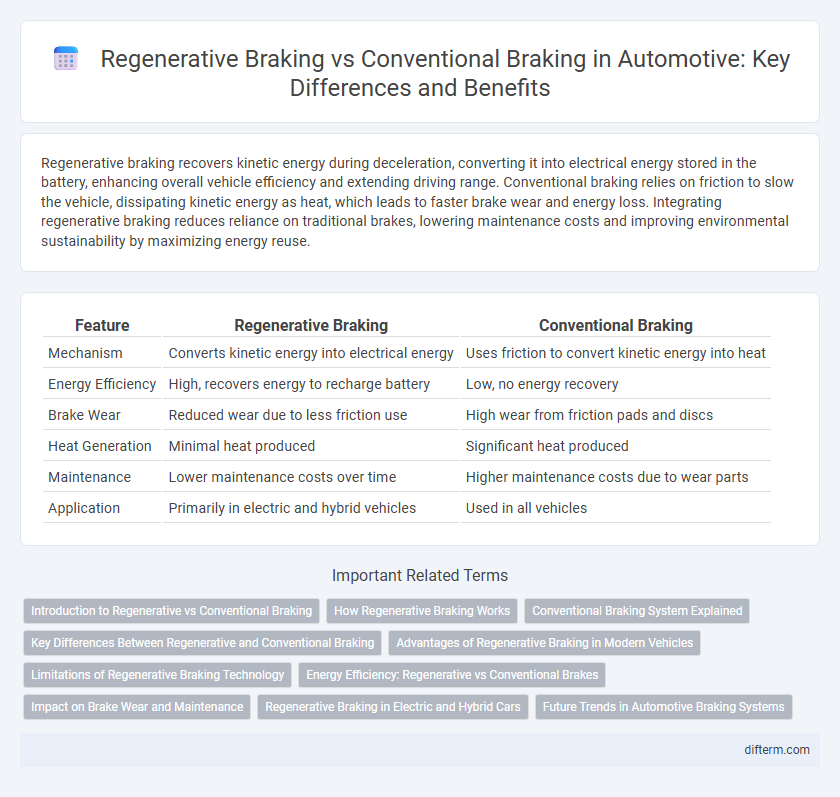Regenerative braking recovers kinetic energy during deceleration, converting it into electrical energy stored in the battery, enhancing overall vehicle efficiency and extending driving range. Conventional braking relies on friction to slow the vehicle, dissipating kinetic energy as heat, which leads to faster brake wear and energy loss. Integrating regenerative braking reduces reliance on traditional brakes, lowering maintenance costs and improving environmental sustainability by maximizing energy reuse.
Table of Comparison
| Feature | Regenerative Braking | Conventional Braking |
|---|---|---|
| Mechanism | Converts kinetic energy into electrical energy | Uses friction to convert kinetic energy into heat |
| Energy Efficiency | High, recovers energy to recharge battery | Low, no energy recovery |
| Brake Wear | Reduced wear due to less friction use | High wear from friction pads and discs |
| Heat Generation | Minimal heat produced | Significant heat produced |
| Maintenance | Lower maintenance costs over time | Higher maintenance costs due to wear parts |
| Application | Primarily in electric and hybrid vehicles | Used in all vehicles |
Introduction to Regenerative vs Conventional Braking
Regenerative braking converts kinetic energy into electrical energy, which is stored in the battery for future use, improving overall vehicle efficiency and reducing fuel consumption. Conventional braking relies on friction to slow down the vehicle, dissipating kinetic energy as heat and offering no energy recovery. Modern automotive systems increasingly integrate regenerative braking for enhanced energy management and environmental sustainability.
How Regenerative Braking Works
Regenerative braking converts kinetic energy from a vehicle's motion into electrical energy, which is stored in the battery for later use, enhancing energy efficiency. Unlike conventional braking that dissipates energy as heat through friction pads, regenerative systems employ the motor as a generator during deceleration. This process reduces wear on brake components and improves overall fuel economy in hybrid and electric vehicles.
Conventional Braking System Explained
The conventional braking system in automotive vehicles relies on friction generated by brake pads pressing against the rotating discs or drums to reduce speed and stop the vehicle. This mechanical process converts kinetic energy into heat, resulting in energy loss and frequent brake component wear. Despite its simplicity and reliability, conventional braking lacks the energy recovery benefits found in regenerative braking systems used in electric and hybrid vehicles.
Key Differences Between Regenerative and Conventional Braking
Regenerative braking captures kinetic energy during deceleration, converting it into electrical energy stored in the vehicle's battery, enhancing energy efficiency and extending electric vehicle range. Conventional braking relies on friction between brake pads and rotors to slow the vehicle, producing heat and dissipating energy without recovery. Regenerative braking reduces wear on brake components and lowers maintenance costs, whereas conventional systems offer more consistent stopping power in emergency situations.
Advantages of Regenerative Braking in Modern Vehicles
Regenerative braking in modern vehicles enhances energy efficiency by converting kinetic energy into electrical energy, which recharges the battery and extends driving range. This system reduces wear on traditional brake components, leading to lower maintenance costs and improved vehicle longevity. Regenerative braking also contributes to decreased greenhouse gas emissions, supporting eco-friendly transportation initiatives.
Limitations of Regenerative Braking Technology
Regenerative braking systems in automotive applications face limitations such as reduced efficiency at low speeds and inability to fully stop the vehicle, requiring supplemental conventional brakes for complete braking power. Energy recovery is less effective on steep descents due to limited battery charging capacity and thermal constraints. Additionally, integration complexity and increased cost pose challenges for widespread adoption in conventional vehicles.
Energy Efficiency: Regenerative vs Conventional Brakes
Regenerative braking systems capture kinetic energy during deceleration and convert it into electrical energy, significantly improving overall energy efficiency by recharging the vehicle's battery. Conventional braking dissipates this energy as heat through friction, resulting in energy loss and lower fuel efficiency. Regenerative brakes enhance energy recovery, reducing wear on mechanical components and extending vehicle range, making them more sustainable for electric and hybrid vehicles.
Impact on Brake Wear and Maintenance
Regenerative braking significantly reduces brake wear by converting kinetic energy into electrical energy, which lessens reliance on friction brakes and extends the lifespan of brake components. Conventional braking systems rely solely on friction to decelerate vehicles, leading to faster wear of brake pads and rotors, resulting in frequent maintenance and replacement. The adoption of regenerative braking systems in electric and hybrid vehicles lowers overall maintenance costs and improves brake system durability.
Regenerative Braking in Electric and Hybrid Cars
Regenerative braking in electric and hybrid cars captures kinetic energy during deceleration, converting it into electrical energy stored in the battery, enhancing overall energy efficiency. This technology reduces wear on conventional brake components by supplementing mechanical braking, extending brake system longevity and lowering maintenance costs. Electric motors serve as generators during braking, enabling vehicles to recover energy that would otherwise be lost as heat in traditional friction brakes.
Future Trends in Automotive Braking Systems
Regenerative braking systems are increasingly integrated into electric and hybrid vehicles to enhance energy efficiency by converting kinetic energy into electrical energy for battery recharge. Conventional friction braking remains essential for safety but is progressively optimized with advanced materials and electronic controls to complement regenerative systems. Future trends indicate a shift towards fully integrated brake-by-wire technology and AI-driven predictive braking, improving energy recovery and vehicle control.
regenerative braking vs conventional braking Infographic

 difterm.com
difterm.com